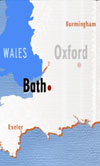Don and the Burke’s Backyard team travelled to the city of Bath, in Somerset. The city is famous for its Roman Baths and natural thermal spring. It is also known for its Georgian architecture, which has received UNESCO World Heritage Site status. The famous Pulteney Bridge was designed by Robert Adam in 1774, and is one of only four bridges in the world lined with shops.
After the fall of the Roman Empire the baths became run down and later forgotten about. They were rediscovered in the 1800s and have now come back into favour as a top tourist attraction and a relaxation and healing centre. Much of the Roman-built site has been excavated and preserved, and it now provides one of the best examples of Roman bathing technology in Northern Europe.
Healing waters
The Celtic people were well aware of the curative powers of the hot springs: in 863BC Prince Bladud supposedly took a dip and had his leprosy cured. He is said to have dedicated the area to the Goddess Minerva.
The Romans arrived in Britain in AD43. They discovered the wonderful thermal springs and established the town of Aquae Sulis, meaning ‘Waters of Minerva’. They developed the baths as a scaled down version of the great baths back home. The original plan included heated rooms, steam rooms, baths, swimming pools, a gymnasium, playing field and social rooms for eating and drinking. Around the site was the Temple of Sulis Minerva. The temple was believed to bring good fortune to those who bathed there.
The ‘Great Bath’ features Roman paving surrounded by 19th Century arcading. This is the focal point of the complex today. The pool is lined with 45 sheets of lead and filled with hot spa water.
Beneath street level there are excavated passages leading to various rooms, the remains of smaller baths and Roman heating chambers. A well very preserved set of pilae can be seen in the West Baths. These are piles of tiles through which hot air circulated to heat the floor and walls of the room above.
The heart of the Roman monument is the 12th Century ‘King’s Bath’, where bathers sat up to their necks immersed in water. This is built around the original sacred spring and is overlooked by a statue of King Bladud. Here more than a million litres of water rise to the surface every day, at a temperature of 46°C. The water contains several minerals including sulfur, iron and calcium. The ruins of the Temple of Sulis Minerva can be seen under the pump rooms.
Further information
Bath is 160 kilometres west of London.
The Roman Baths open every day except Christmas Day and Boxing Day.
Official website: www.romanbaths.co.uk



